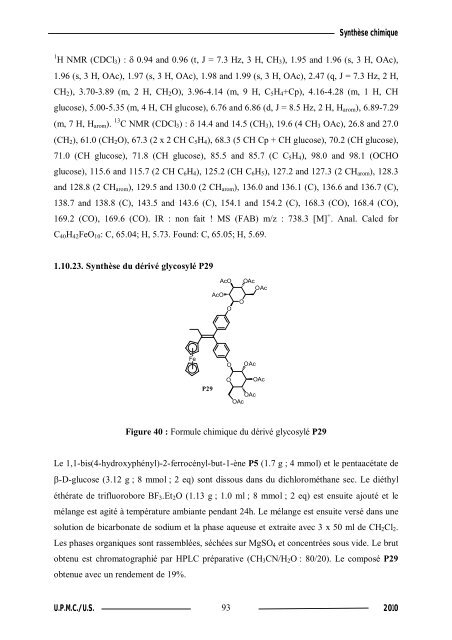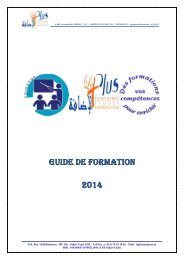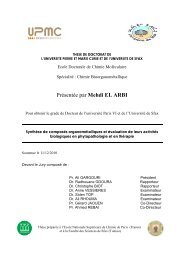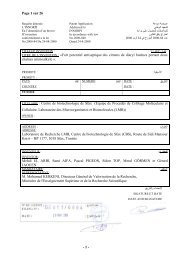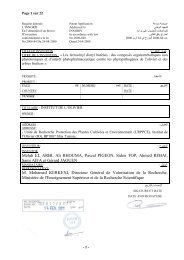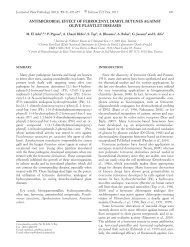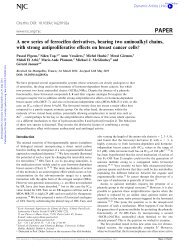Create successful ePaper yourself
Turn your PDF publications into a flip-book with our unique Google optimized e-Paper software.
<strong>Synthèse</strong> chimique<br />
1 H NMR (CDCl3) : � 0.94 and 0.96 (t, J = 7.3 Hz, 3 H, CH3), 1.95 and 1.96 (s, 3 H, OAc),<br />
1.96 (s, 3 H, OAc), 1.97 (s, 3 H, OAc), 1.98 and 1.99 (s, 3 H, OAc), 2.47 (q, J = 7.3 Hz, 2 H,<br />
CH2), 3.70-3.89 (m, 2 H, CH2O), 3.96-4.14 (m, 9 H, C5H4+Cp), 4.16-4.28 (m, 1 H, CH<br />
glucose), 5.00-5.35 (m, 4 H, CH glucose), 6.76 and 6.86 (d, J = 8.5 Hz, 2 H, Harom), 6.89-7.29<br />
(m, 7 H, Harom). 13 C NMR (CDCl3) : � 14.4 and 14.5 (CH3), 19.6 (4 CH3 OAc), 26.8 and 27.0<br />
(CH2), 61.0 (CH2O), 67.3 (2 x 2 CH C5H4), 68.3 (5 CH Cp + CH glucose), 70.2 (CH glucose),<br />
71.0 (CH glucose), 71.8 (CH glucose), 85.5 and 85.7 (C C5H4), 98.0 and 98.1 (OCHO<br />
glucose), 115.6 and 115.7 (2 CH C6H4), 125.2 (CH C6H5), 127.2 and 127.3 (2 CHarom), 128.3<br />
and 128.8 (2 CHarom), 129.5 and 130.0 (2 CHarom), 136.0 and 136.1 (C), 136.6 and 136.7 (C),<br />
138.7 and 138.8 (C), 143.5 and 143.6 (C), 154.1 and 154.2 (C), 168.3 (CO), 168.4 (CO),<br />
169.2 (CO), 169.6 (CO). IR : non fait ! MS (FAB) m/z : 738.3 [M] + . Anal. Calcd for<br />
C40H42FeO10: C, 65.04; H, 5.73. Found: C, 65.05; H, 5.69.<br />
1.10.23. <strong>Synthèse</strong> du dérivé glycosylé P29<br />
Fe<br />
P29<br />
AcO OAc<br />
OAc<br />
AcO<br />
O<br />
O<br />
U.P.M.C./U.S. 93<br />
2010<br />
O<br />
O<br />
OAc<br />
OAc<br />
OAc<br />
OAc<br />
Figure 40 : Formule chimique du dérivé glycosylé P29<br />
Le 1,1-bis(4-hydroxyphényl)-2-ferrocényl-but-1-ène P5 (1.7 g ; 4 mmol) <strong>et</strong> le pentaacétate <strong>de</strong><br />
�-D-glucose (3.12 g ; 8 mmol ; 2 eq) sont dissous dans du dichlorométhane sec. Le diéthyl<br />
éthérate <strong>de</strong> trifluorobore BF3.Et2O (1.13 g ; 1.0 ml ; 8 mmol ; 2 eq) est ensuite ajouté <strong>et</strong> le<br />
mélange est agité à température ambiante pendant 24h. Le mélange est ensuite versé dans une<br />
solution <strong>de</strong> bicarbonate <strong>de</strong> sodium <strong>et</strong> la phase aqueuse <strong>et</strong> extraite avec 3 x 50 ml <strong>de</strong> CH2Cl2.<br />
Les phases organiques sont rassemblées, séchées sur MgSO4 <strong>et</strong> concentrées sous vi<strong>de</strong>. Le brut<br />
obtenu est chromatographié par HPLC préparative (CH3CN/H2O : 80/20). Le composé P29<br />
obtenue avec un ren<strong>de</strong>ment <strong>de</strong> 19%.


